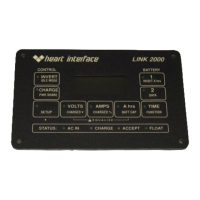5/31/96
25
PERCENTAGE OF AVAILABLE CAPACITY FROM A
100 Ahr BATTERY AT DIFFERENT DISCHARGE RATES
USING DIFFERENT PEUKERT'S EXPONENTS
DISCHARGE RATE IN AMPS
n 5 10 16.7 25 50 75 100 150 200 250 300 400 500
1 100 100 100 100 100 100 100 100 100 100 100 100 100
1.1 100 93 88 85 79 76 74 71 69 67 66 64 63
1.2 100 87 78 72 63 58 55 51 48 46 44 42 40
1.25 100 84 74 67 56 51 47 42 40 37 36 33 32
1.3 100 81 69 62 50 44 41 36 33 31 30 27 25
1.4 100 76 61 52 40 34 30 26 23 21 20 17 16
1.5 100 71 55 45 32 26 22 18 16 14 13 11 10
Example #1: Suppose you have a 200 Ahr bat-
tery. Now discharge at a 50 Amp rate until the
battery reaches 1.75V per cell (10.5V for a 12V
battery). This would be equivalent to a discharge
rate of 25A for a 100 Ahr battery. If the battery
delivered 67% (134 Ahr) the appropriate
Peukert's exponent would be 1.25.
Example #2: A 100 Ahr battery with
a Peukert's exponent of 1.3 will de-
liver only 41% of its capacity (41 A
hr) when supplying a 100A load.
EXPONENT
HIGH DISCHARGE RATES
& PEUKERT'S EQUATION
The table below may be used to understand the effect of high rates of discharge on
available battery capacity. It may also be used to estimate the exponent "n" for a battery
after a single discharge test. The table is based on a 100 Ahr battery but may be used for
any capacity battery by using an appropriately scaled current. See the examples below:

